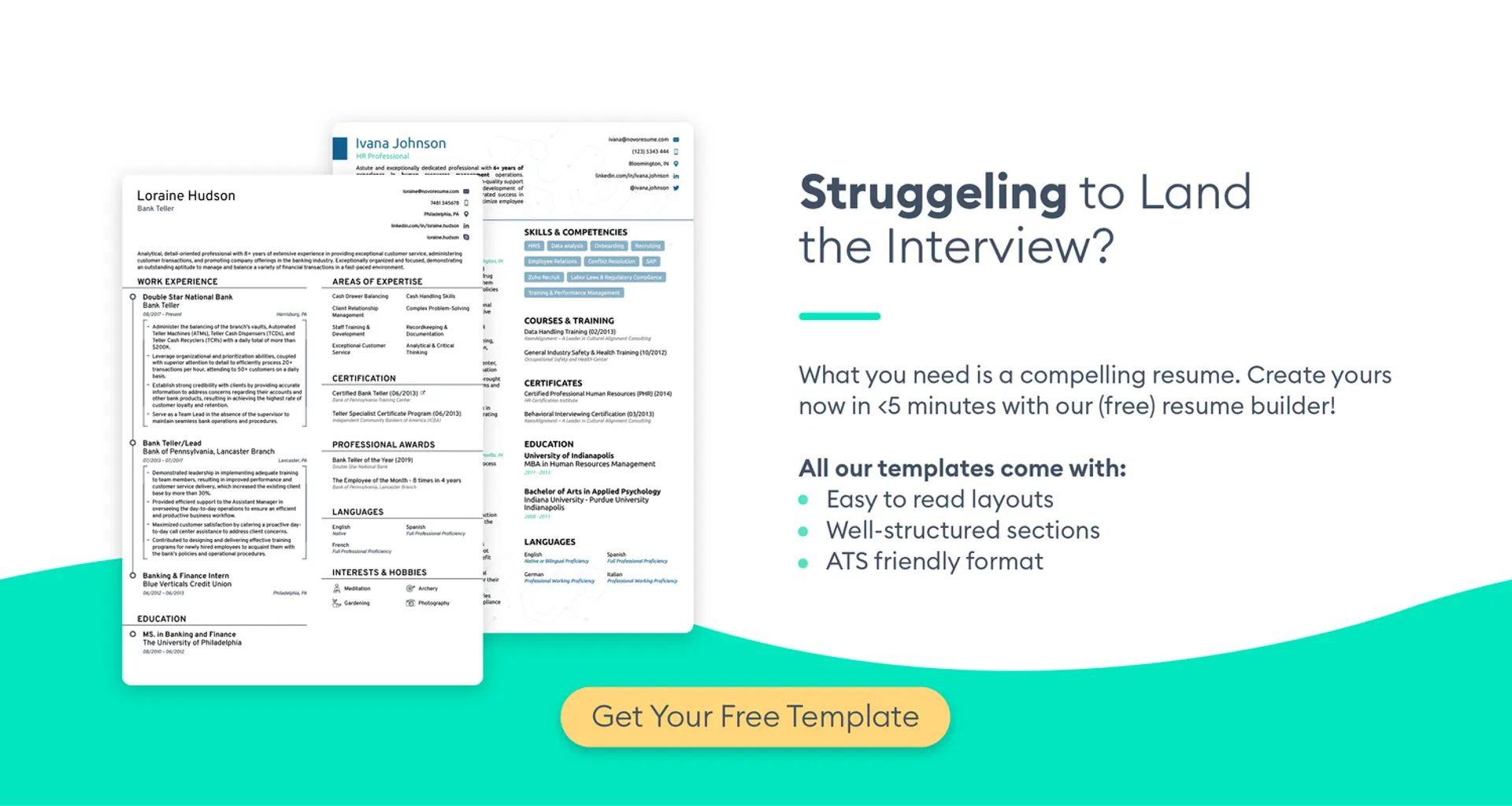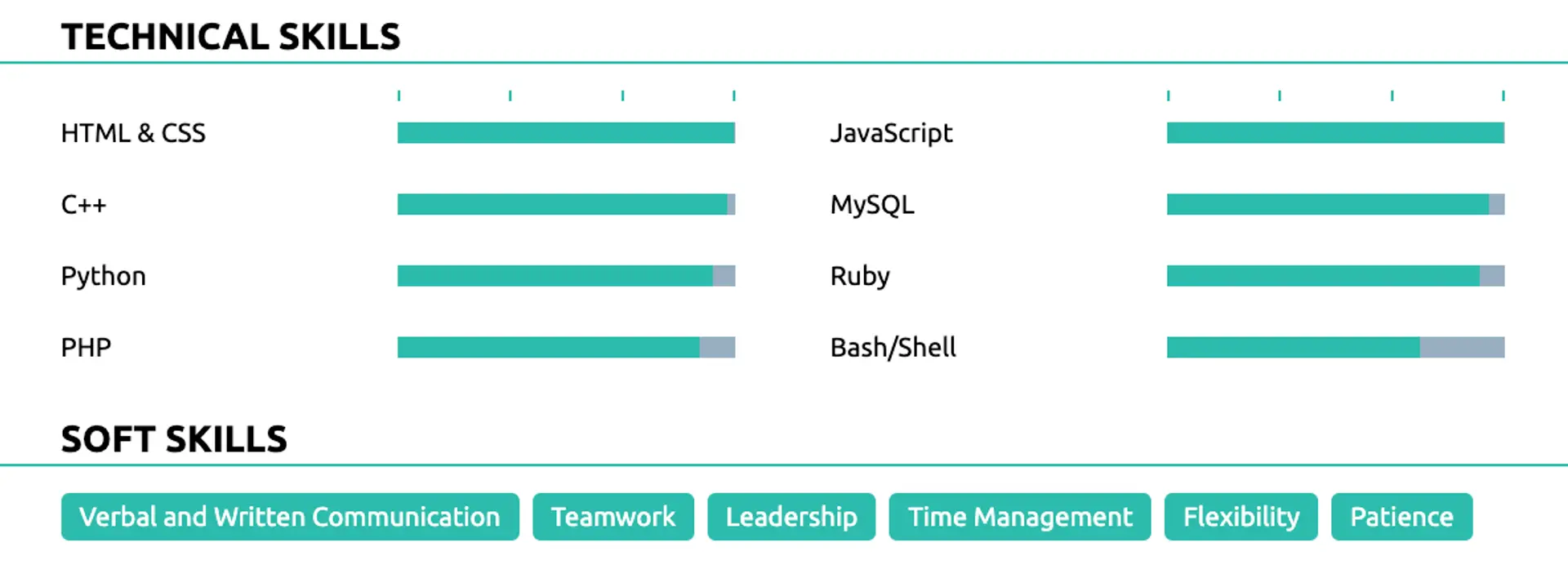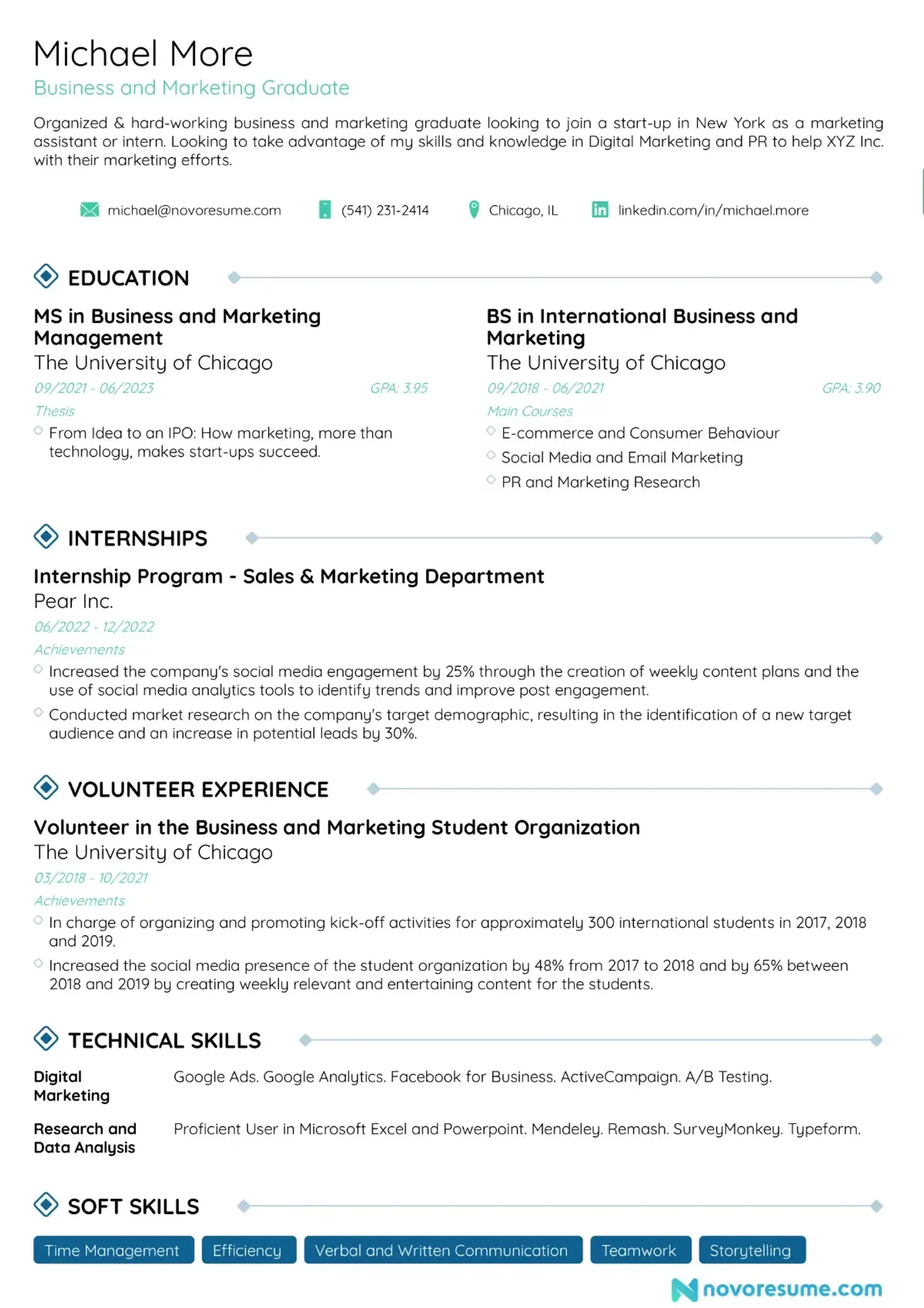CV Looks Empty? Here’s What To Do (9+ Tips & Tricks for 2025)
Updated on 09/15/2025

You’re on the hunt for your next job and you’ve already sat down and updated your CV.
The only problem? It looks empty.
You added all the information you could think of, but it’s just not enough to fill up the page.
The problem? An empty-looking CV will make you come off as inexperienced to potential employers, which could cost you your dream job.
But don’t worry.
In this article, we’re going to tell you about all the ways you can use to fill up your CV.
We’re going to cover:
- 5 Tips To Format An Empty-Looking CV
- 5 Ways To Fill Up A CV That Looks Empty
- 3 Examples of CVs With No Experience
- And more!
Let’s dive in!
5 Tips To Format An Empty-Looking CV
The reason your CV looks empty might have nothing to do with its contents.
For example, you may have simply chosen the wrong template or CV layout. A poorly designed template may be using space ineffectively and in turn leaving your CV looking empty.
So let’s take a look at some tips to help you best format your CV so it looks full.
#1. Pay attention to the layout
You want your CV layout to be just right. That includes using the right font, not having too much white space, and getting each section perfectly aligned.
Here are some basics of a CV layout you should keep in mind:
- Line spacing. Use 1.0 to 1.15 line spacing for the text on your CV, whether it’s in between the main body of your text or in between section subheadings and text. If you adjust this according to the space on your CV, you can make it look fuller.
- Bullet points. List your academic responsibilities, work experience, and skills in bullet points, not paragraphs. But don’t overdo it - six bullet points per entry is enough. This will make your CV easier to read, and use up any empty space you might have.
- Save as PDF. Once you make your CV look as full as possible, you want to make sure it stays that way. Save your CV as a PDF file instead of an MS Word or Google Docs file to ensure the contents of it don’t shift when a hiring manager opens it on a different device.
Amongst the most common CV mistakes many job seekers make that cause their CV to look empty is going for an overused single-column CV template.
For example, the Europass CV is an extremely popular choice from a bygone era. But if you don’t have a lot of information to include on your CV, it will likely end up looking empty and uninteresting.
Instead, you should choose a professional CV template with a tidier layout that makes the best use of space and design elements. Novoresume has dozens of CV templates approved by HR professionals that users can easily fill in and customize through our CV builder.
With a Novorésumé template, you won’t have to ever worry about the layout making your resume look empty.

#2. Pick the best format
The gold standard for a CV is the reverse-chronological format (also known as the chronological format).
This CV format lists your experience in reverse chronological order, starting with your most recent place of employment and education, as well as your most recent projects and certifications, and moving further back in time.
Not just that, but you can also include detailed descriptions of your achievements and responsibilities underneath each entry and for each section, too, all of which can further help you fill up your resume.
#3. Adjust the margins
One reason your CV might look empty is that you got the margins wrong.
If your CV’s margins aren’t adjusted, it might create a lot of empty space on the page and your CV will look empty.
As a rule, the margins on your CV should be one inch on all sides.
You can avoid the hassle of adjusting the margins altogether by using a professional CV builder and picking a template that’s appropriate for your level of experience.
#4. Use the right font
The font you choose for your CV can also affect how it ends up looking.
If your CV looks empty, your font might be the wrong size.
For starters, your font size should be uniform throughout your CV, with 10-12pt being recommended for text. To make your CV look fuller, consider using a 12pt font size.
For section titles and headers, on the other hand, 14-16pt is the standard, so you can opt for the 16pt to take up more space.
The font style you choose also plays a part in how full your CV looks. Most CVs use Times New Roman but if you want to try a font that leaves less room on the page, we recommend choosing a different font that still has a professional look.
#5. Coordinate the colors
The colors you choose to use on your CV matter.
If, for example, you choose too many colors in the same palette, they might blend into the background and make your CV look flat.
Similarly, contrasting colors can make your resume look cluttered and uneven, so you want to avoid those, too.
Go for colors that complement each other for the best effect. It’s good practice to use a dark color and a light color. Make sure your font color also contrasts with its background, so keep it dark on light backgrounds, and vice versa.
Most CV builders come with creative designs and built-in palettes you can choose from, so picking the right combination of colors for your industry and personality takes no more than a few seconds.
5 Ways To Fill Up A CV That Looks Empty
If you followed all our tips above and your CV still looks empty, chances are it’s from a lack of content.
No worries!
We’ve prepared a list of tips you can follow to get a head start on filling up your CV and making it look less empty, starting with:
#1. Expand on your contact information
Typically, the most important contact information is your email address and phone number.
Most candidates also include where they’re based, listing their city, state, or country.

However, if your CV looks too empty, consider adding optional contact information such as a link to your LinkedIn or other professional profile.
If you’re a designer, you might want to provide a link to your portfolio or Behance profile, while a software engineer should focus on GitHub, StackOverflow, or similar platforms.
While it’s not a huge addition to your CV’s content, it might help give your CV a fuller look and get the hiring manager to check your work.
#2. Include a CV objective
The very top of your CV should include a short pitch of your professional and educational career that can get the hiring manager interested in reading the rest of your CV.
This is sometimes called a personal statement, which can be written in one of two ways:
- CV Objective - Emphasizes your professional aspirations and goals, your top skills, and your educational background to highlight what makes you the right candidate for the position.
- CV Summary - Focuses on your professional history, including how many years you’ve worked, your work experience, and your most relevant achievements so far.
dWe recommend writing a CV summary only if you have enough relevant experience to make it compelling. Generally speaking, practical work experience sells you best as a candidate.
However, if you’re new to your field and don’t have much experience you can show off, stick to writing a CV objective instead.
Here’s an example of a well-written CV objective:
Well-written CV Objective:
- Hard-working service industry worker seeking to apply for the server position at XYZ Restaurant. Past experience includes working as a bartender, busser, and line cook. Thrives in a fast-paced, high-stress environment.
#3. Focus on your skills
One of the most important sections on your CV is your skills section since it’s one of the first things hiring managers look at.
However, hard skills aren’t the only thing hiring managers are on the lookout for.
According to Forbes, employees need soft skills to thrive at their job, which is why hiring managers pay close attention to both types of skills when going through candidates.
So, you can list your skills in bullet points or columns and even consider including your proficiency level for hard skills to make your CV look fuller.
Here’s an example from a web developer’s CV:

By adding a proficiency level next to your hard skills, you make good use of what would otherwise be empty space, and you give the hiring manager a practical idea of how skilled you really are.
For example, when listing different computer skills, your proficiency with different tools and software products can take up a lot of space on your CV and it can make your application more impressive.
#4. Elaborate on your education
If you find there’s too much leftover space on your CV, you can always elaborate on your educational history.
Whereas it’s enough for seasoned professionals to just list their degree, university name, and years of study, you can add more “meat” to this section by going into detail about any relevant or noteworthy academic achievements.
Here’s an example of a detailed education section for your CV:
Education Section on CV Example:
B.Sc. in Mechanical Engineering and Civil EngineeringUniversity of California, Berkeley2018 - 2022- GPA: 3,90
- Classes: Mathematics, Electrical Circuits, Thermodynamics, Engineering Economy
- Dissertation: How Can the Design of Mixed-Use High-Rise Buildings Provide a Solution to Urban Sprawl and Increase Sustainability, Walkability, and Well-Being in Cities?
#5. Leverage Optional Sections
While these sections are optional, they can add a lot of value to your CV and fill it up considerably. So, add any of these optional sections to fill up the empty space on your CV:
- Volunteer work. This section includes any unpaid work you’ve done, and according to studies, it’s often a path toward employment. Consider listing your tasks and anything impressive you may have accomplished, and provide a timeframe, scale, and results if applicable.
- Foreign languages. Knowing a foreign language can make you stick out from other candidates. And, to make this section even more detailed, list the languages you know by your level of proficiency.
- Extracurricular activities. This section is especially important for recent graduates. Clubs or societies you participated in on-campus can go here and show the hiring manager that you’re an active participant in school life, not just a learner.
- Hobbies and interests. This section lets your personality shine through and could make you stand out from a crowd of candidates with similar skills and experiences. That said, be sure to focus on hobbies and interests that show you’re aligned with your target company’s values, such as community service, teamwork, or creativity.
- Personal projects. Your personal projects are those passions you’ve actively pursued, rather than simply dabbled in. So if you created a club or ran a successful blog, this is the section where you can highlight it.
- Internships. Any internships you’ve done are a great stepping stone to a job. Internships show you have some hands-on work experience, as well as knowledge of the position you interned in. If your internship was very closely related to the industry you’re applying for, it could even be listed under the work experience section.
- Certifications and awards - Showing off some of your extra achievements never hurts. Make sure to add the name of the award or certification and the relevant dates underneath. If the name is too vague, include a short description of what it's about.
- Publications - This section is always welcome if you’re an academic or some sort of writer. Your most recent or most relevant publications can be added in this section with a URL that leads to the work.
3 Examples of CVs With No Experience
#1. High School Student CV

#2. College Student CV

#3. Entry-Level CV

5 Other Resources For Job Seekers
Landing your dream job will take more than simply filling up your CV.
It will require finding the right position, preparing a spotless application that includes a cover letter, getting ready for interviews, and more.
Check out these useful links to get a head start:
- 30+ Jobs for Teenagers (Where & How to Look). Looking for any sort of practical work experience? These jobs are a great starting point for students of all ages, from high schoolers to college seniors looking for a part-time gig.
- 340+ Resume Action Verbs & Power Words [For 2025]. Using the proper language will make sure your CV will pack a punch. Take a look at the words best suited to get your point across to the hiring manager and leave a lasting impression.
- How to Network in College [10 Tested Ways, Benefits & Tips]. An introduction to professional networking is always a good idea when you’re on the hunt for opportunities. Expanding your professional network comes with tons of benefits, including scoring jobs that can help you fill up your work experience section.
- How to Write a Cover Letter in 2025 | Beginner’s Guide. Adding a cover letter to your job application considerably increases your chances of getting an interview. Learn how to write the perfect cover letter in our article.
- 35+ Job Interview Questions and Answers [Full List]. The key to acing your job interview is proper preparation. Read up on the most common questions interviewers ask, and how to best answer them to prove you’re the right candidate.
Key Takeaways
And that’s a wrap on what you should do if your CV looks empty!
We hope that after reading this article you no longer have any empty space on your CV to worry about.
But before you start applying for jobs, let’s recap some of the main points we covered in the article:
- If your CV looks empty, try adjusting the layout first. It’s possible that your line spacing, margins, or font size aren’t appropriate.
- Make sure to pick the right format for your level of experience. The classic reverse-chronological format might not be the best choice if you’re a recent graduate or in the midst of a career change.
- Leverage optional sections to fill in any leftover space. Sections such as volunteer work, personal projects, and foreign languages are all great options you can choose from.
- You can always go out into the world and gain new experiences such as internships or volunteer roles. Then, add those to your CV before you apply for your dream job.
